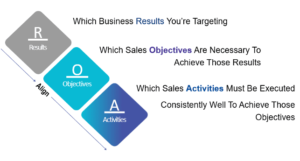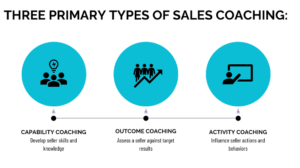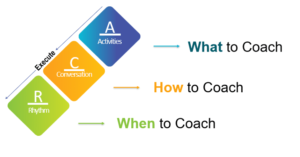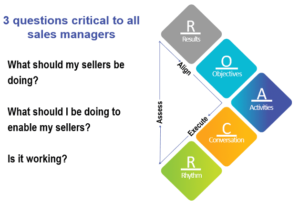Organizational Agility: The Most Effective Way to Achieve More Sellers at Quota

Our research shows that sales managers who focus on Organizational Agility, and coach to activities, get 35% more of their sellers to quota.
What is Organizational Agility?
Organizational Agility is the ability to match the marketplace reality and sales execution to organizational goals and desired results.
Organizations that have frameworks around linking market-facing sales activities with KPIs and organizational results are much more agile because they can switch gears easier, and shift activities to align with changing results and changing conditions.
In other words, Organizational Agility is the alignment between the activities your salespeople execute and your organization’s desired results.
This alignment is key because when circumstances change, organizations, and sales managers specifically, need to identify which activities will accomplish their new objectives, and ultimately achieve results.
So now that you know the basics, let’s break down the key components of Organizational Agility.
Consistently Aligning Salesperson Activities to Desired Organizational Results
Do you know which activities that your salespeople execute are the most closely correlated with your desired results?
Digging into this question and answering it for your team is the first step in becoming agile as an organization.
In our research, we found hundreds of metrics that very large organizations use to measure and manage their sales forces. Then we sorted through these metrics looking for patterns.
What we learned was that there’s no one size fits all approach to managing and measuring a sales force, just as there’s no one size fits all approach to the sales process. Just as different buyers have different needs, different organizations have different objectives.
That is perhaps the greatest benefit to the Organizational Agility framework. It can be molded to work with any sales process and adapted to help managers coach the activities prescribed within.
So, if you want to figure out what activities to coach to, start backward.
• First figure out which business Results you’re targeting
• Then Determine which sales Objectives are necessary to achieve those results
• And finally decide what sales Activities must be executed consistently well to achieve those results.

If this is sounding familiar, that’s because it’s the same idea behind both Foundational and Situational agility. Overall, the Sales Agility framework is about assessing needs, whether they be the needs of your customers or your sales team, and then identifying solutions.
The next step in our organizational Agility journey is to explore how to coach these activities once you’ve identified them.
Why Coaching Is Key to Execution
What are the primary types of Sales Coaching? Our research has found three.

On the surface, all these coaching strategies might seem effective, but we’ve found that only one really is.
Capability coaching, which we imagined would be highly correlated with quota attainment, was almost negligible, with only a 2% impact on quota attainment across our studies.
Coaching to results scored slightly higher, with a 10% variance in quota attainment.
Activity Coaching won by far. It was the most impactful strategy, as well as the only coaching strategy that was statistically, significantly correlated with quota attainment, at 24%.
So why does Activity Coaching win out over the other two primary types of sales coaching? Activity Coaching allows sales managers a level of focus and efficiency not offered by capability or results coaching.
An ancillary benefit to Activity Coaching, and our previous step of aligning your objectives with these activities, is that in digging into specific activities, managers and sellers become more aware of what activities they should be laser focused on.
In other words, there is greater clarity among sellers about their roles, and what they’re expected to do. In fact, Harvard Business Review examined what motivated salespeople the most, and Clarity of task was paramount.
Clarity of task is the direct connection between the activities you’re asking salespeople to execute and the results you’re holding them accountable to achieve.
So, by becoming more aligned and agile as an organization, not only will your sales coaches be more effective by narrowing down the activities they coach, but your salesforce will be happier knowing they know exactly what activities they need to execute.
Building an Efficient and Focused Coaching Rhythm
So now that you know that Activity Coaching is so effective, how do you decide what activities to coach, and how often? Your organization no doubt has countless activities that your sellers perform across all stages of the buying process and coaching them all is unfeasible.
Determining what to coach should follow this framework:
• Decide what activities will have the highest impact and are most aligned to sales objectives.
• Determine the structure of the coaching conversation and focus on one to two most important activities per coaching session.
• Build a rhythm of these structured coaching conversations and determine the most effective frequency and duration for them

Does this mean that all other sales activities are forgotten about and not coached? Absolutely not. It just means that you are prioritizing certain activities over others, and what we’ve found is that the most effective sales leaders are “maniacal” in prioritizing the activities that are most aligned with targeted sales objectives.
And if you’ve taken the time to develop this coaching rhythm and focused your coaching conversations down to those highest impact activities, the execution will follow.
This leads us to the final piece of Organizational Agility…
Assessing if You’re on the Right Track
Business and sales are ever-evolving. Environments change, business conditions change, sales roles change, and markets change.
That’s why sales leaders must be able to change with them and find new activities to coach to in order to keep in alignment with the desired objectives.

If you’ve followed the framework up until now, it should be very clear if the activities that have been coached to are moving the needle on your objectives because they will be in alignment with them.
However, if you are not hitting those objectives, you might need to think again about the activities you’ve chosen to coach, and if they’re the best aligned with your KPIs.
You might also need to investigate the rhythm and structure of your coaching conversations to see if they’re effectively driving the execution you need to hit those objectives.
Final Thoughts
While it is a simple framework, achieving Organizational Agility is not easy, but it is worth it. Our clients have consistently agreed that working with sales management to improve their coaching is the most critical component to achieving their sales goals.
If you follow the framework outlined above your organization will have better alignment between sales activities and results, a more effective and efficient coaching process, a more focused and happier sales team, and more sellers at quota.
Our Offerings
The Sales Management Code™ equips sales managers with a simple, yet powerful framework for aligning seller and manager efforts to desired business results, coaching in ways that drive maximum impact, and assessing leading indicators of progress to determine if sellers are on the right path to quota.
The Pipeline Coaching Code™ equips sales managers and leaders with a powerful framework for assessing the health of the pipeline, considering size, contents, and progress. It then equips managers to make deliberate decisions about how to ensure the health of the pipeline and the viability of deals within the pipeline. Managers will reorient effort toward the early stages of deals to improve deal viability and velocity.
VantagePoint Performance is now part of Imparta, a global leader in performance improvement for customer-facing teams.